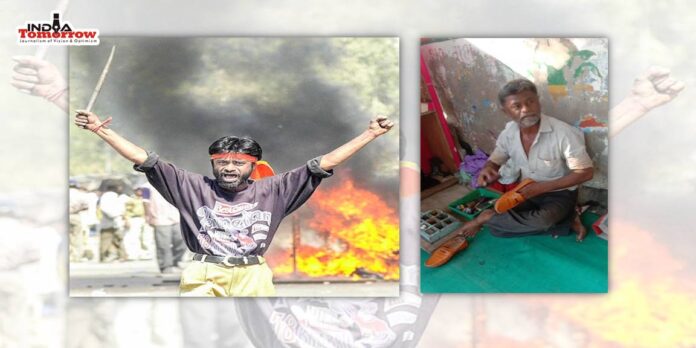Syed Khalique Ahmed
AHMEDABAD—Two decades have passed since the Gujarat Genocide in 2002. However, Ashok Mochi, who was 29 then and became famous for his iconic photograph with a saffron band around his head and a steel rod in one of his hands, feels no remorse about the mass massacre of Muslims. On the contrary, his picture became a symbol of perpetrators of violence in February-March 2002.
He says the anti-Muslim violence was a consequence of the Godhra train burning, a language used by some of the Gujarat BJP politicians who said that there is a reaction to each action.
“No, I don’t feel any remorse. The anti-Muslim riots in 2002 was a Hindu anger against the killing of kar sevaks in Sabarmati train at Godhra,” says Mochi with pride.
“My picture representing the Hindu rage became the face of Hindu community’s anger against the Godhra massacre,” Mochi says in a video interview with India Tomorrow.
“One could feel the anger of the Hindu community in my picture,” he elaborates. “However, at that time, I did not know that the riots would be so terrible and at such a large scale,” he says.
“Lekin meri tasveer ko riots se jod diya gaya, is ka mujhe afsos hai,” (But I regret that my picture has been linked with the riots), he says, pleading that he did not take part in the riots at all. However, he says that his picture became the reason for the registration of FIR against him and his arrest. Finally, he was acquitted by a court as no evidence was found against him.
Mochi says that he had posed for the photographs willingly, not at any individual or organization’s behest. “And my picture was an “Aakash” (fury) of “aam aadmi” (common man) against the Godhra happening,” he points out
He distances himself from being a member of the Bajrang Dal, as reported by the media at that time. However, his answers to the questions and his language indicate Mochi being a well-trained individual by some radical organizations.
The 49-year-old Mochi, hailing from the Dalit community, works as a cobbler on the footpaths of Shahpur and lives in an adjoining school as he has no house of his own. He says that whatever he earns is hardly enough to provide him with food and clothing. Moreover, he has no money to buy a house.
He is unmarried.
Being repeatedly apologetic about his picture, he says, “I had not posed for the pictures for publicity, or for earning money. I did so only out of anger,” he claims.
Talking about how he was photographed, he says he was standing at a chowk(crossroad) in Shahpur area where a hoarding with a slogan “Hindu Rashtra Ke Karnavati Shahar Mein Aap ka Swagat hai” (You are welcome to the Karnavati city of the Hindu Rashtra) had been put up by the VHP. Goods looted from Muslim shops were being burnt at the chowk.
“As there was a saffron band around my head, some people took me for a leader of BJP/VHP or Bajrang, and they raised slogans of “Jai Shri Ram” on seeing me. And I also responded to them by repeating the same slogans. Meanwhile, a photographer reached there. He questioned me about the Godhra incident, and I told him that what happened at Godhra was not good and Ahmedabad is burning due to that only. People have come out in the streets and are targeting the local Muslims who are innocent. However, I was speaking in extreme anger. The photojournalist said that my anger and ‘aakrosh’ are okay, but I should pose for a picture. So I expressed my “aakrosh” in front of the VHP hoarding while shouting slogans of Jai Shri Ram and stretching my hand that became an iconic picture representing the Gujarat anti-Muslim violence,” he elaborates. However. Mochi claims that he did not take any direct part in the violence.
Why did Mochi not marry? “My being a Dalit, poor, my riot photograph as ‘Hindu samaj ka chehra’(face of the Hindu community), registration of an FIR, and firing on me are among many reasons for not getting a bride,” he replies.
“My picture was circulated all over India, all over the globe. A large number of journalists took my interviews. But even after 20 years, no one from VHP, Bajrang Dal, BJP, or RSS came to offer me any financial help,” he says, perhaps trying to prove that he has no association with Hindu radical or ultra-nationalist political organizations. But, on the other hand, maybe he wants to prove that if he had been connected with any of them, he would have been helped.
Mochi is brilliant in answering questions. He parries answers to inconvenient questions. Instead of answering why the VHP and other radical Hindu organizations don’t help him financially, he tried to divert the interview to the attack on him by what he calls ‘Jihadi’ people. He says when the ‘Jihadis’ (a contemptuous and hateful word for Muslims by far-right Hindu groups) saw his picture in a poster printed by Bajrang Dal and VHP activists, “they (Jihadis) fired on me, but I was luckily saved.”
“Yet, nobody from VHP/Bajrang Dal or BJP and RSS came to help me because I am not affiliated to any of these organizations,” he claims.





